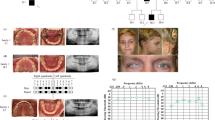Abstract
Tooth agenesis is the most common developmental dental anomaly. Absence of one or two permanent teeth is found in the majority of affected subjects. Very few patients suffer severe tooth agenesis. Recent studies revealed that WNT10A gene mutations caused syndromic and isolated severe tooth agenesis. In this study, to determine the contribution of WNT10A variants in different severities of tooth agenesis, we investigated the association between WNT10A variants and non-syndromic tooth agenesis in a Chinese population consisting of 505 tooth agenesis patients and 451 normal controls. Twenty-three novel non-synonymous variants were identified. WNT10A variants were detected in 15.8 % (75/474) of patients with 1–3 missing teeth and 51.6 % (16/31) of patients with 4 or more missing teeth. As compared with a frequency of 3.1 % in individuals with full dentition, variant allele frequencies were significantly elevated in both groups with tooth agenesis (p values of 1.00 × 10−6 and 3.89 × 10−23, respectively). Our findings showed that WNT10A variants were associated with non-syndromic tooth agenesis from mild to severe tooth agenesis, and the more severe tooth agenesis, the stronger association. Biallelic genotypes of WNT10A variants may have a pathogenic effect on tooth development. Presence of a single variant allele would be predisposing for causation with low penetrance. Together with WNT10A variant, there should be other genetic or environmental factors leading to biallelic variant-related variable clinical manifestations and single allele variant-related low penetrance. The frequent missing tooth positions in the WNT10A-related cases were consistent with that in the general population, suggesting WNT10A plays a critically important role in the etiology of general tooth agenesis.
Similar content being viewed by others
References
Adaimy L, Chouery E, Megarbane H et al (2007) Variant in WNT10A is associated with an autosomal recessive ectodermal dysplasia: the odonto-onycho-dermal dysplasia. Am J Hum Genet 81:821–828
Bergendal B, Klar J, Stecksén-Blicks C, Norderyd J, Dahl N (2011) Isolated oligodontia associated with variants in EDARADD, AXIN2, MSX1, and PAX9 genes. Am J Med Genet A 155A:1616–1622
Bohring A, Stamm T, Spaich C et al (2009) WNT10A variants are a frequent cause of a broad spectrum of ectodermal dysplasias with sex-biased manifestation pattern in heterozygotes. Am J Hum Genet 85:97–105
Castori M, Castiglia D, Brancati F et al (2011) Two families confirm Schöpf-Schulz-Passarge syndrome as a discrete entity within the WNT10A phenotypic spectrum. Clin Genet 79:92–95
Cluzeau C, Hadj-Rabia S, Jambou M et al (2011) Only four genes (EDA1, EDAR, EDARADD, and WNT10A) account for 90% of hypohidrotic/anhidrotic ectodermal dysplasia cases. Hum Mutat 32:70–77
Graber LW (1978) Congenital absence of teeth: a review with emphasis on inheritance patterns. J Am Dent Assoc 96:266–275
Lammi L, Arte S, Somer M et al (2004) Variants in AXIN2 cause familial tooth agenesis and predispose to colorectal cancer. Am J Hum Genet 74:1043–1050
Mostowska A, Biedziak B, Zadurska M, Dunin-Wilczynska I, Lianeri M, Jagodzinski P (2012) Nucleotide variants of genes encoding components of the Wnt signalling pathway and the risk of non-syndromic tooth agenesis. Clin Genet. doi:10.1111/cge.12061 (Epub ahead of print)
Nagy N, Wedgeworth E, Hamada T, White JM, Hashimoto T, McGrath JA (2010) Schöpf-Schulz-Passarge syndrome resulting from a homozygous nonsense variant in WNT10A. J Dermatol Sci 58:220–222
Nawaz S, Klar J, Wajid M et al (2009) WNT10A missense variant associated with a complete odonto-onycho-dermal dysplasia syndrome. Eur J Hum Genet 17:1600–1605
Polder BJ, Van’t Hof MA, Van der Linden FP, Kuijpers-Jagtman AM (2004) A meta-analysis of the prevalence of dental agenesis of permanent teeth. Community Dent Oral Epidemiol 32:217–226
Rølling S, Poulsen S (2001) Oligodontia in Danish schoolchildren. Acta Odontol Scand 59:111–112
Sarnas KV, Rune B (1983) The facial profile in advanced hypodontia: a mixed longitudinal study of 141 children. Eur J Orthod 5:133–143
Sjöholm MI, Dillner J, Carlson J (2007) Assessing quality and functionality of DNA from fresh and archival dried blood spots and recommendations for quality control guidelines. Clin Chem 53:1401–1407
Song S, Han D, Qu H et al (2009) EDA gene variants underlie non-syndromic oligodontia. J Dent Res 88:126–131
Stockton DW, Das P, Goldenberg M, D’Souza RN, Patel PI (2000) Variant of PAX9 is associated with oligodontia. Nat Genet 24:18–19
Stritzel F, Symons AL, Gage JP (1990) Agenesis of the second premolar in males and females: distribution, number and sites affected. J Clin Pediatr Dent 15:39–41
Symons AL, Stritzel F, Stamatiou J (1993) Anomalies associated with hypodontia of the permanent lateral incisor and second premolar. J Clin Pediatr Dent 17:109–111
van den Boogaard MJ, Créton M, Bronkhorst Y et al (2012) Mutations in WNT10A are present in more than half of isolated hypodontia cases. J Med Genet 49:327–331
Van Geel M, Gattas M, Kesler Y et al (2010) Phenotypic variability associated with WNT10A nonsense variants. Br J Dermatol 162:1403–1406
Vastardis H (2000) The genetics of human tooth agenesis: new discoveries for understanding dental anomalies. Am J Orthod Dentofacial Orthop 117:650–656
Vastardis H, Karimbux N, Guthua SW, Seidman JG, Seidman CE (1996) A human MSX1 homeodomain missense variant causes selective tooth agenesis. Nat Genet 13:417–421
Wedgeworth EK, Nagy N, White JM, Pembroke AC, McGrath JA (2011) Intra-familial variability of ectodermal defects associated with WNT10A variants. Acta Derm Venereol 91:346–347
Woolf CM (1971) Missing maxillary lateral incisors: a genetic study. Am J Hum Genet 23:289–296
Acknowledgments
We thank Professor Jianyuan Luo for his critical reading of the manuscript. This work was supported by grants from the Natural Science Foundation of China (81101181), and the National Key Health Research Project Foundation of China during the 12th Five-Year Plan Period (2012BAI09B04).
Author information
Authors and Affiliations
Corresponding authors
Electronic supplementary material
Below is the link to the electronic supplementary material.
Rights and permissions
About this article
Cite this article
Song, S., Zhao, R., He, H. et al. WNT10A variants are associated with non-syndromic tooth agenesis in the general population. Hum Genet 133, 117–124 (2014). https://doi.org/10.1007/s00439-013-1360-x
Received:
Accepted:
Published:
Issue Date:
DOI: https://doi.org/10.1007/s00439-013-1360-x




